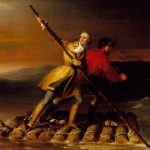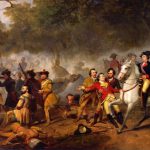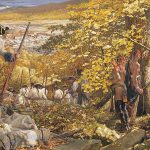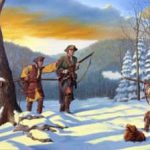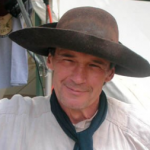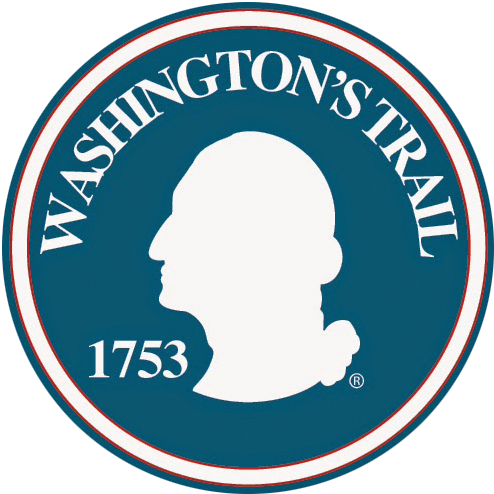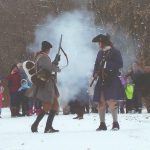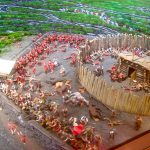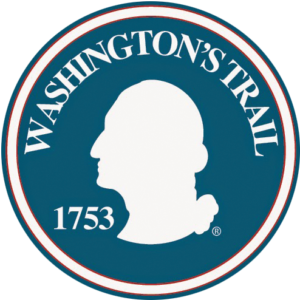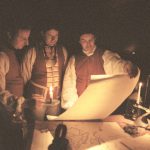Timeline
The French and Indian War, also called the Seven Years’ War in Europe and the Great War for Empire by some historians, decisively shaped American history and changed the map of North America.
Scroll through the timeline to read highlights of some of the events and battles that led to the greatest loss of life on American soil in the 18th century. Many of these places mentioned can still be visited today.
⇅
1753
1753
French troops from Canada march south; seize and fortify the Ohio Valley. Britain protests the invasion and claims Ohio for itself. From October 1753 through the following January, Twenty-one-year-old George Washington carried a British ultimatum to French Fort de la Riviere aux Boeufs (Fort LeBoeuf) demanding French withdrawal from western Pennsylvania – a 1000 mile round trip in winter weather.
- Fort Presque Isle (Erie, PA) is constructed by the French who then build a road south to a new post at LeBoeuf (present-day Waterford, PA).
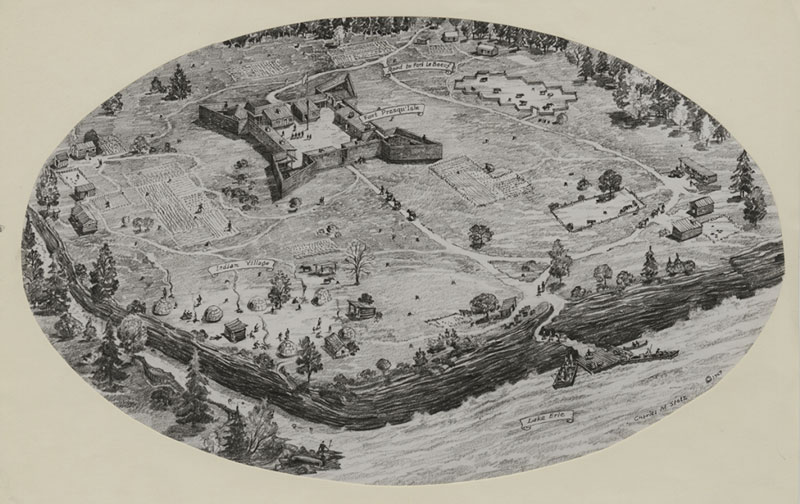
- The French seize Scots trader, John Fraser’s cabin at the confluence of French Creek and the Allegheny River, and establish a presence there. Eventual site of Fort Machault.
October 1753
- George Washington is commissioned by Lt. Gov. Dinwiddie, and leaves Williamsburg, Virginia, carrying a letter from Gov. Dinwiddie to the French, ordering them to vacate the British territory.
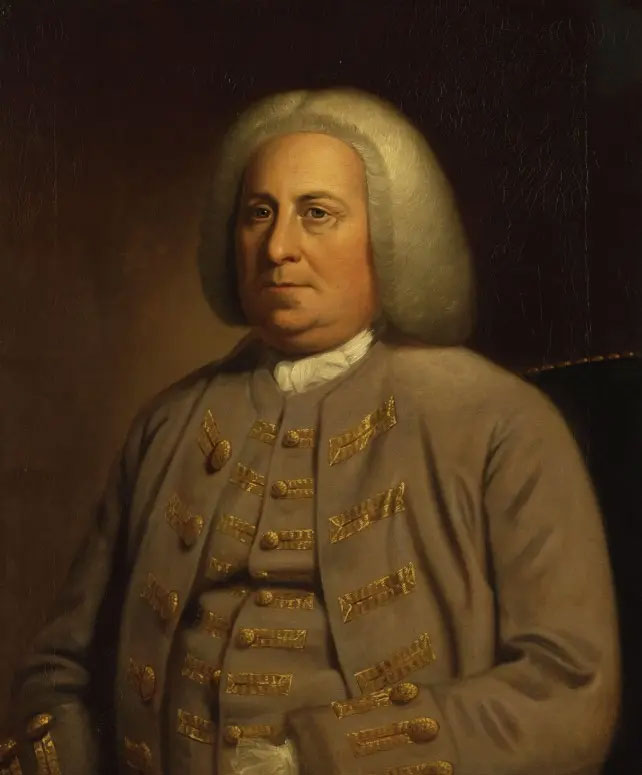
November 1753
- Christopher Gist joins Washington at Wills Creek (Cumberland, MD) and the next day they enter the forests of southwestern Pennsylvania.
- Later, George Washington writes in his journal – ‘the excessive rains and vast quantity of snow that had fallen, prevented our reaching Mr. Frazier’s, an Indian Trader, at the Mouth of Turtle Rock, on Monongahela.’ They arrive at the Forks of the Ohio (now the City of Pittsburgh, PA) where Washington surveys the site for a future British fort. After standing at the point where the Ohio River begins in Pittsburgh, Washington writes in his journal, “As I got down before the Canoe, I spent some Time in viewing the Rivers, & the Land in the Fork, which I think extremely well situated for a Fort; as it has the absolute Command of both Rivers.”
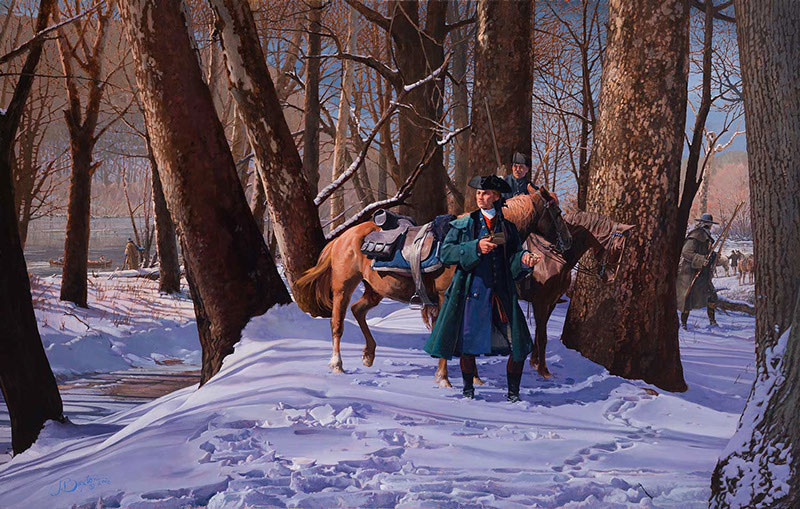
- George Washington arrives at Logstown to obtain information about location of French forts. He then meets in Council at Logstown with leaders from the Six Nations of the Iroquois. After a few days, Washington and Gist leave Logstown for Venango, accompanied by Half-King and “two old men and one young warrior.”
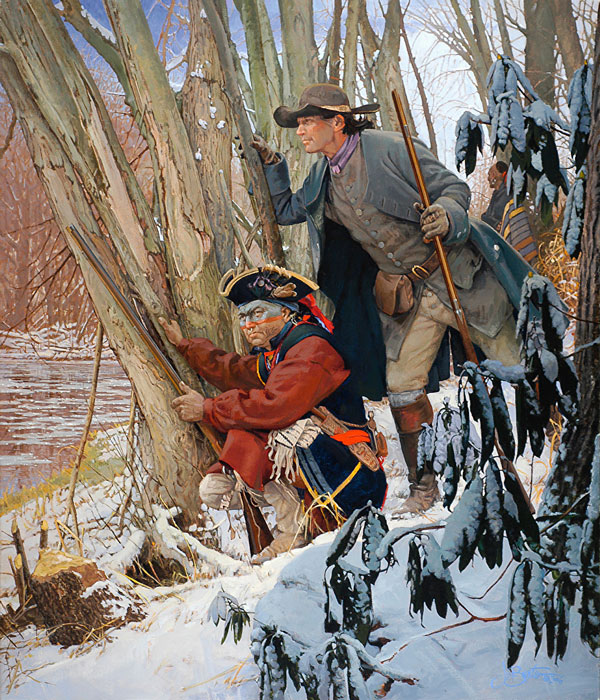
December 1753
- George Washington arrives in present-day Franklin and attempts to deliver the letter to the French. They instruct him he needs to travel further north to Fort LeBoeuf.
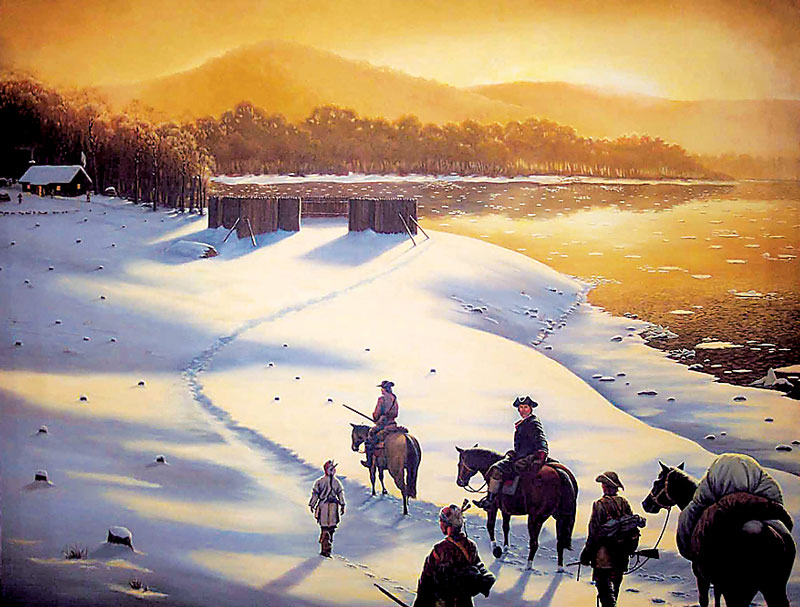
- As he and Gist continue north, they camp overnight along the creek bank in present-day Meadville. When they arrive at Fort sur la Riviére aux Boeufs (Ft. LeBoeuf), Washington delivers the British Crown’s message to the French commander.
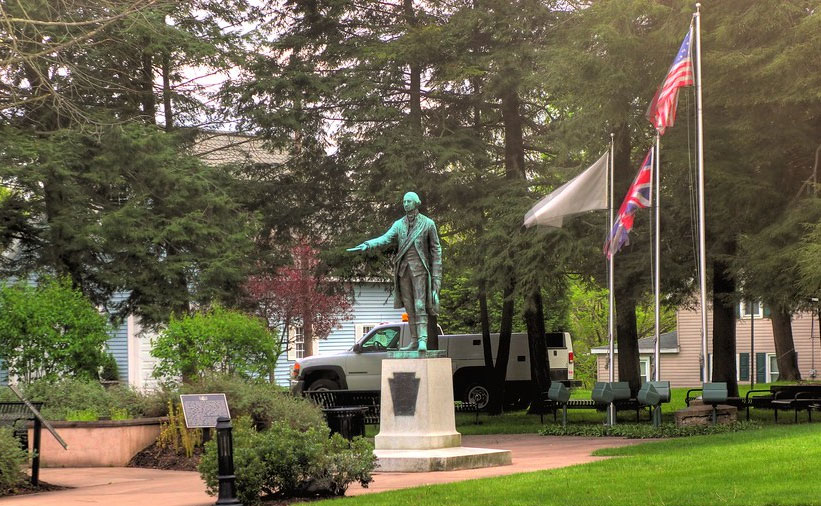
- Washington and Gist leave Fort LeBoeuf to return back to Williamsburg with the reply from the French. Near “Murthering Town” (near present-day Harmony, PA), Washington is shot at by an Indian guide but escapes harm.
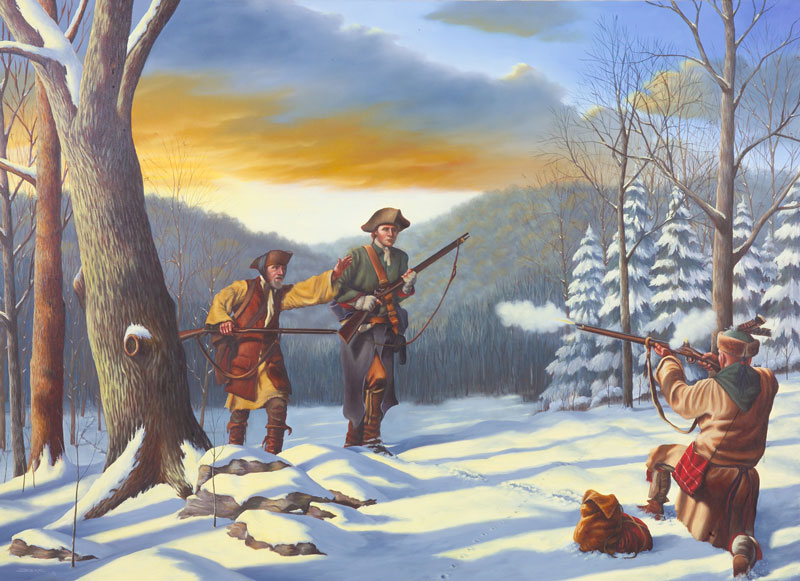
- Washington and Gist, in trying to cross the Allegheny River near Shannopin’s Town, two miles upstream of the Forks of the Ohio, fall off the raft and nearly drown. They spend the night on an island and finish crossing the river on the frozen ice the next day.
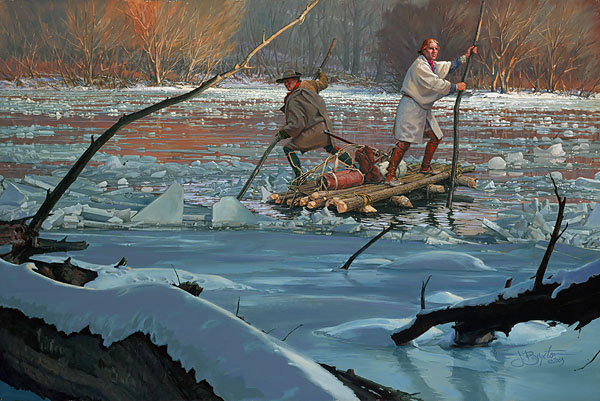

Young George Washington.
1754
1754
George Washington returns to Williamsburg and delivers the French commandant’s reply to Governor Dinwiddie, thus setting the stage for the French and Indian War. Ensign de Jumonville and a third of his escort is killed by a British patrol led by George Washington. In retaliation the French and the Indians defeat the British at Fort Necessity. Washington surrenders after losing one-third of his force.
January 1754
- George Washington arrives in Williamsburg in January and delivers the French commandant’s reply to Governor Dinwiddie, thus setting the stage for the French and Indian War.
February 1754
- The British take command of the Forks of the Ohio in February and start to construct Fort Prince George, also known as Trent’s Fort.
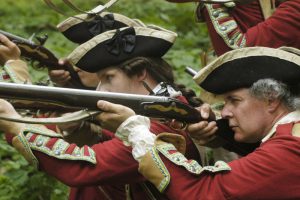
April 1754
- By April, the British Fort Prince George is surrendered to the French at the Point (present-day Pittsburgh); The French now control the Forks of the Ohio and immediately begin the construction of Fort Duquesne.
- Meanwhile, Washington assumes command of the Colonial forces at Fort Cumberland after the death of its leader Joshua Frye, and Washington’s Virginia Army marches to meet the French threat in the Ohio Valley.
May 1754
- On May 28, George Washington led 40 men from an encampment near present-day Uniontown, PA to an Indian camp where 10 or 11 warriors joined them. They set off to investigate reports of a French camp a few miles away (present day Jumonville Glen). Not long after dawn, the two forces exchanged fire, leaving four Virginians and fourteen Frenchmen dead or wounded. The French commander, Ensign Joseph Coulon de Villiers, Sieur de Jumonville, was killed. Washington’s troops then build Ft. Necessity in a lowland meadow northwest of present-day Farmington, PA, a few miles from the site of Ensign Jumonville’s death.
July 1754
- July 3, the French and the Indians attacked Washington’s troops who had built a “fort of necessity”, killing or wounding one-third of Washington’s men after a day of constant firing in heavy rain. The fort was captured and burned, Washington surrendered, and on July 4 was allowed to retreat.
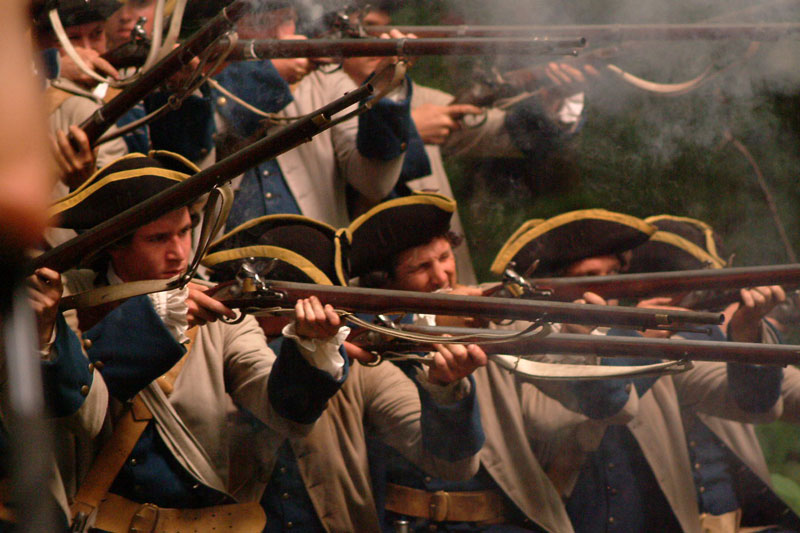
French soldiers
1755
1755
The British implement a plan to defeat the French. Moncton successfully captures Fort Beausejour, Major General Edward Braddock troops are defeated in the Battle of the Monongahela, and William Johnson’s troops stop the French advance at Lake George.
Following Washington’s surrender at Fort Necessity in 1754, the British government sent Major General Edward Braddock and a force of 1300 British regular and colonial militia to Fort Duquesne. George Washington returns to the frontier as an aide to General Braddock. As Braddock marches with his army to attack French Fort Duquesne, they build an impressive hundred-mile-long wilderness road.
July 1755
- On July 9, after a double fording of the Monongahela River to the site of present-day Braddock (near Pittsburgh), the army encounters about 900 French and Indian troops. In the ensuing three-hour firefight, Braddock’s command suffers more than 1000 casualties before the survivors flee. The French and Indians suffer about 50 casualties.
- Braddock is wounded. George Washington leads the troops in retreat to Dunbar’s Camp (near Jumonville, and the present-day site of Jumonville Camp and Conference Center.) There, Colonel Thomas Dunbar carries out Braddock’s orders to destroy 150 wagons and tons of supplies. General Braddock, mortally wounded, dies near Jumonville Glen, and his body is buried under the road so that it cannot be found. Braddock’s defeat unleashes two years of attacks by the Indians, and effectively rolls the Pennsylvania frontier back to Carlisle, barely 100 miles from Philadelphia.
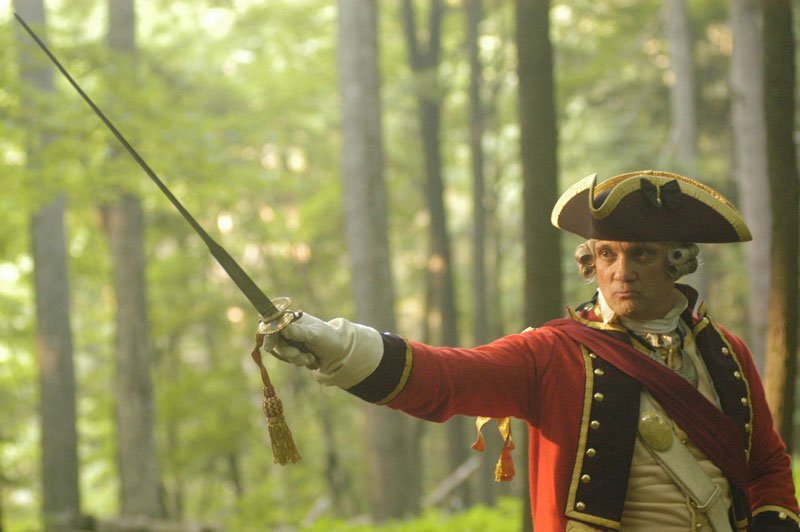
General Braddock
1756
1756
Over the next several years, French and Indians launch hit-and-run attacks on British frontier settlements. The Seven Years’ War begins as Great Britain declares war on France expanding the North American conflict to Europe, Africa, Asia and South America.
May 1756
- Great Britain and France and their allies mutually declare the “Seven Years War,” called the “French and Indian War” in America. Fighting spreads to the West Indies, India and Europe. French General Montcalm (mon-kahlm) arrives in Quebec. He does not like depending on American Indian allies and over time he changes the way the French fight the war.
July 1756
- British Fort Granville (near Lewistown, Mifflin County, PA) is destroyed by the Delaware war chief Captain Jacobs. British Lord Loudoun arrives in New York. He threatens the colonies and treats them badly. They do not like his behavior and resist helping him. This hurts the British war effort.
August 1756
- The French capture the British Fort Oswego and take control of Lake Ontario.
September 1756
- Pennsylvania Colonel John Armstrong leads 307 colonial soldiers on a secret, retaliatory surprise attack against the Indians, attacking and destroying a major Delaware Indian village in Kittanning (PA), home to Chief Shingas and Captain Jacob. An explosion kills Captain Jacob and his family and liberates 24 prisoners.
1757
1757
The French led by Montcalm capture Fort William Henry. Following the surrender, Montcalm’s actions anger his Indian allies who capture or kill hundreds of unarmed British.
- A letter arrives from British Secretary of State William Pitt, changing the policies of Lord Loudoun. Now the colonies are very supportive of the war.
- The French capture Fort William Henry, located at the south end of Lake George in New York. However, they do not talk with their American Indian allies about the surrender. The surrender agreement angers the American Indians and the next day they capture or kill hundreds of British.
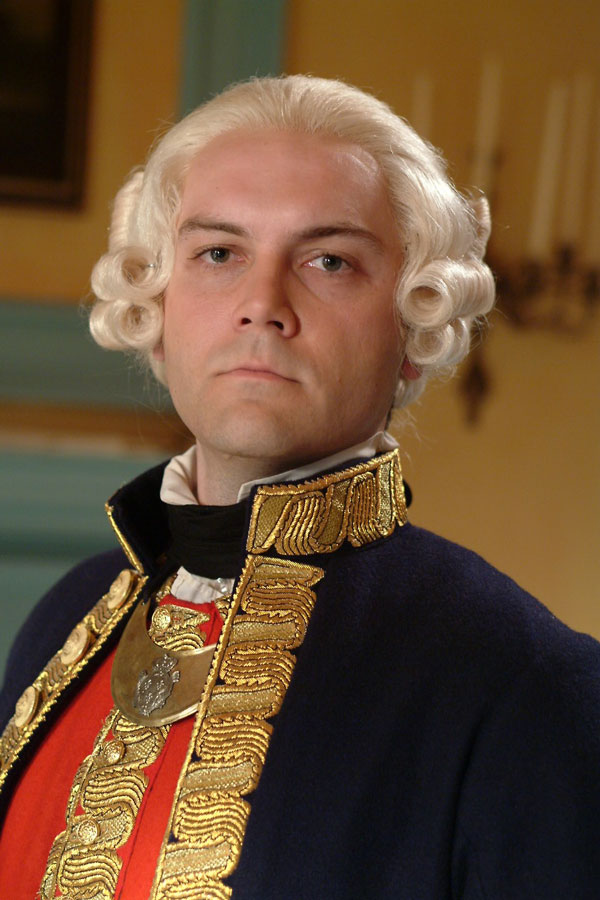
General Montcalm
1758
1758
William Pitt implements cooperative policies toward colonial legislatures to receive more colonial support for the war, the Treaty of Easton is signed with the Six Nations, and the British take control of the Forks of the Ohio.
-
- General John Forbes leads a “protected advance” across Pennsylvania to again attack French Fort Duquesne. Fort Bedford is constructed at today’s Bedford, PA as a key fortification and staging area along the Forbes Road military path.
- Despite having many more troops, the British did not take Fort Ticonderoga near the south end of Lake Champlain in New York.
- The British capture the fortress at Louisbourg at Cape Breton in Nova Scotia province. This opens the St. Lawrence River and the water route to Canada.
- The British capture Fort Frontenac at present-day Kingston, Ontario province. This fort supplied all the French forts in the Ohio River Valley and further west.
- The “Post at Loyalhanna” (Fort Ligonier) is built on orders from General Forbes as a supply depot and staging area for a British-American army of 5000 troops, the jumping-off point for the last stage of Forbes’ march.
- Battle of Grant’s Defeat. A British force under Major James Grant is defeated within view of Fort Duquesne. This French victory weakens Fort Duquesne as many of their Indian allies leave after the victory.
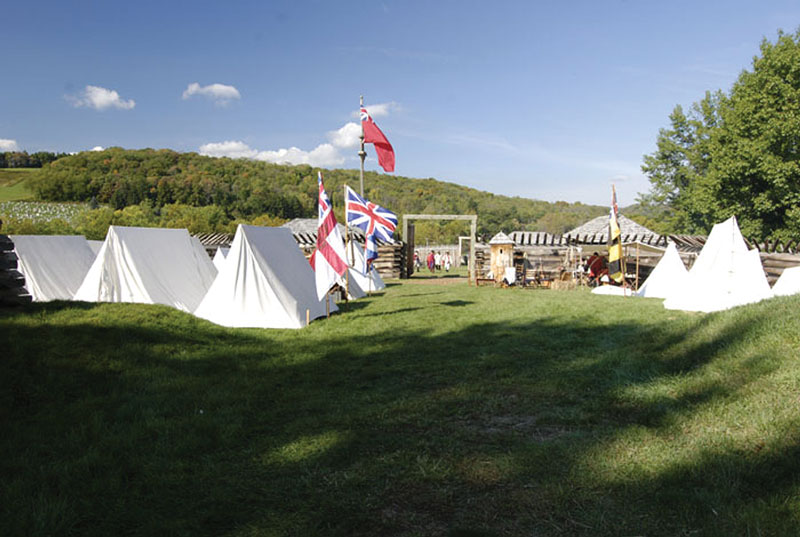
- The Ohio River Valley American Indians sign the Treaty of Easton promising not to fight for the French. In return the British promise not to settle the lands west of the Allegheny Mountains after the war.
- With supplies and native allies dwindling, Fort Duquesne commander Francois-Marie le Marchand, Sieur de Ligneris, launches a desperate raid to destroy Fort Ligonier. In the ensuing three-hour battle, Pennsylvania Colonel James Burd loses dozens of men but successfully defends the fort.
- Encouraged by reports that the French garrison at Fort Duquesne is shrinking and that their allies, the Delaware Indians, are prepared to abandon the French and make peace, Brigadier General John Forbes decides to mount an early assault.
- As the British forces march towards Fort Duquesne, the French set fire to the fort, blow up its walls, and they retreat upstream along the Allegheny River. On November 26 the British seize control of the Forks of the Ohio and rename it as “Pittsbourgh.”
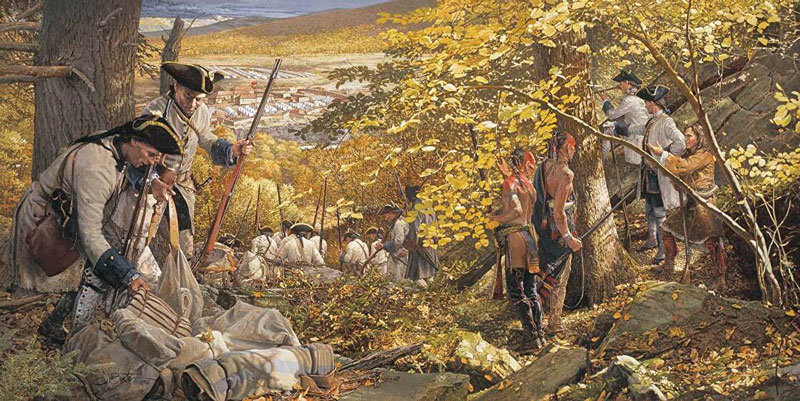
1759
1759
French surrender Quebec after a battle outside the city on the Plains of Abraham.
- The Iroquois decide to ally with the British and help them defeat the French at Fort Niagara. The French surrender Fort Niagara to the British after a long fight.
- The French army retreats and the British capture Fort Ticonderoga and Crown Point in New York.
- The French surrender the city of Quebec after the British defeat them in an early morning battle just outside the city.
- Construction of Fort Pitt (Pittsburgh, PA) begins.
1760
1760
The British capture Montreal ending the conflict between the French and the British in North America. The British and French are still fighting in other parts of the world.
1761
1761
Jeffery Amherst changes the trading practices with the American Indians. The new rules cause the American Indians to suffer great hardship.
1762
1762
The British capture the Spanish city of Havana, Cuba and bring another European power into the war.
1763
1763
The Spanish, French and British sign a peace treaty, the Treaty of Paris, ending the French and Indian War. Much of North America changes hands. In an effort to stop all the American Indian fighting, King George III signs the Proclamation of 1763, which requires British colonists to live east of the Allegheny Mountains.
- Pontiac holds a council and plans to attack Fort Detroit. He unites many American Indian nations in an effort to drive British soldiers off their land.
- Pontiac and his warriors attack Fort Detroit. The American Indians attack and burn eight British forts and settlements. Both Fort Pitt and Fort Detroit are surrounded without help or supplies.
- Col. Henry Bouquet (boo-kay) attempts to relieve Fort Pitt. On August 5, near Bushy Run Battlefield (PA), American Indians attack. The next day Bouquet tricks the American Indians and drives them off.
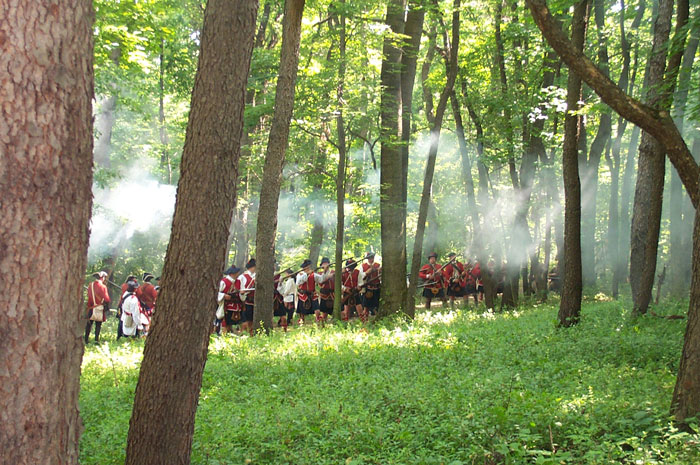
- Siege of Fort Pitt is lifted with the arrival of Colonel Bouquet’s forces.
- King George III signs the Proclamation of 1763, which requires British colonists to live east of the Allegheny Mountains.
1764
1764
The British Sugar Act is amended to tax the American colonies.
1765
1765
Pontiac’s War ends. Seeds of unrest are sown that will lead to the American Revolution.
- Sugar Act and the Currency Act protests. Many colonists refuse to use imported English goods. Seeds of unrest are sown that will eventually lead to the American Revolution.
- The British change their policy regarding trade with the American Indians, which the American Indians find agreeable. The American Indians make peace with the British and end Pontiac’s War.
